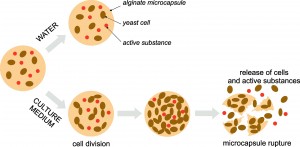Petra Janská, Jitka Čejková, František Štěpánek
The controlled release of active substances (e.g. drugs, fragrance, probiotics, nutrient preservatives) from man-made capsules is of considerable interest in many applications. A variety of chemical and physical methods have been developed to release capsule contents, release triggers are frequently based on mechanical, chemical, biological, electrical, thermal, photo, or magnetic stimuli.
According to our best knowledge, cell growth trigger is a novel mechanism not described in literature yet. We have prepared unique alginate microcapsules with encapsulated yeast cells (they serve as the triggers for capsule rupture because of their growth), iron oxide magnetic nanoparticles (they facilitate easy manipulation with capsules by using magnet) and liposomes loaded with fluorescein (it serves as a model released substance). Figure shows the mechanism of microcapsule rupture. Under unfavourable condition in the absence of nutrients no cell division occurs, therefore the microcapsules containing yeast cells are stable in water for long time and do not disintegrate neither release their content. By contrast, in microcapsules exposed to culture medium with nutrients, cell divide and their growth causes the rupture of alginate capsule and release of embedded components.

Schematic principle of microcapsule rupture and release of submicrometre objects into the environment caused by yeast cell growth in the culture medium. In water microcapsules are stable and no release of cells neither active substance occurs.
Publications
- Čejková J., Haufová P., Gorný D., Hanuš J., Štěpánek F. (2013), Biologically triggered liberation of sub-micron particles from alginate microcapsules, J. Mater. Chem. B 1 (40), 5456-5461.
- Čejková J., Haufová P., Gorný D., Štěpánek F.: ”Artificial spores” – hybrid alginate microcapsules with encapsulated yeast cells, ECAL 2013 (12th European Conference on Artificial Life), Taormina, Italy, 2.-6.9.2013.
